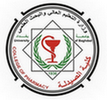The College of Pharmacy discussed the MSc thesis entitled “Preparation and Evaluation of Lornoxicam Surface Solid Dispersion as an Ophthalmic Dosage Form” by the student Riyam Sadiq Jaafar and the supervisor, Assistant Professor Dr. Hanan Jalal Kassab, at the PharmaceuticsDepartment . The study aimed to improve the aqueous solubility of lornoxicam by formulating it as a solid surface dispersion (SSD) using hydrophilic, water-insoluble carriers. The optimized SSD was subsequently incorporated into an ion-sensitive ophthalmic gel designed to prolong the drug’s retention time in the eye, thereby improving its therapeutic efficacy in managing ocular inflammation.The study includedthe preparation of 30 formulations of solid surface dispersions (SSDs) using three distinct methods: kneading, solvent evaporation, and microwavetechniques. Five different carriers were utilized: Avicel PH101, Aerocel 200, sodium starch glycolate (SSG), croscarmellose sodium (CCS), and crospovidone (CP).Following this, evaluate the influenceof the preparation method, carrier type, and drug-to-carrier ratio on the solubility and dissolution characteristics of the resulting dispersions. The SSDs were subjected to comprehensive analyses, including determination of yield, drug content, solubility, and in vitro drug release, with results compared to those of pure lornoxicam.The optimized formulation was subsequently employed to develop eight ion-sensitive ocular gel formulations, incorporating 0.1% w/w of lornoxicam using gellan gum at varying concentrations. These formulations underwentlaboratory and biological evaluation to assess their potential for enhancing ocular drug delivery. The in vivo performance of the selected formulation was further examined using a rat model to validate its efficacy and drug delivery capabilities.The study concluded that among the various formulations, SSD11 (1:5 drug-to-carrier ratio), prepared via the kneading method using crospovidone as the carrier, demonstrated superior performance. It achieved a high yield of 98.5% and a drug content of 95.39%, with a remarkable 147-fold increase in solubility compared to pure lornoxicam. This formulation exhibited rapid drug release, with 93.19% of the drug released in phosphate buffer solution (pH 7.4) within 10 minutes, in contrast to only 24.81% from the pure drug.When incorporated into an ion-sensitive ophthalmic gel containing 0.8% gellan gum, the formulation maintained its gel state for 335±4.082 minutes. It demonstrated a drug content of 94.2±0.852%, viscosity of 811 cP, and osmolality of 378±10.614 mOsmol. In vitro release studies showed 90% drug release within 30 minutes. Furthermore, in vivo testing on rats confirmed that the formulation was well-tolerated, with no signs of ocular irritation or allergic reactions observed.The study recommendedthat further in vivo investigations be conducted in animal models to establish the effective dose of lornoxicam when administered as an ocular formulation. This additional research would facilitate the extrapolation of the effective dose to a human equivalent, thereby optimizing the drug’s therapeutic benefits in treating ocular inflammation.





